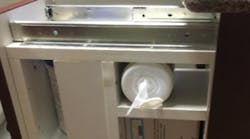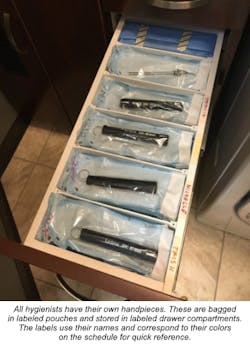3 simple organization steps to increase dental practice productivity, safety, and patient perception
To say Dr. Joen Iannucci, professor of clinical dentistry at Ohio State University, knows a thing or two about being organized is an understatement. She wrote the book, Dental Radiography: Principles and Techniques while holding positions as professor, director of admissions, and director of sterilization monitoring services.
In fact, when they learned she was my (author Karen Daw) mentor, it was not uncommon for her former classmates and students to ask, “Is she still as organized as I remember?” Dr. Iannucci is the most organized person I know, and maybe even the most organized person on the planet!
“An organized area provides a professional image for your practice and allows you to take pride in your work. You will get more done, have less stress, and be more efficient. Being organized is being in control!”
Dental practice manager Tiffany Thomas agrees. “It’s easy to see when something is needed when all rooms are set up identically. This reduces stress for the team because they can quickly identify if an item needs to be stocked. Also, it's not a problem for the team to move from one room to the next, which allows for patients to be taken care of in a timely manner.
"Being organized ensures that we’re sending a positive message to our patients by eliminating some of the shuffling that can happen in a practice. It reduces team frustration and makes it easy to focus on patients’ needs.”
What if your team members were not born with an innate sense of organization like Dr. Iannucci, or are not well-versed in organization strategies like Tiffany? I (author Emily Robinson) am a marriage and family therapist, and I understand firsthand how unkept and unorganized spaces can lead to anxiety and reduced efficiency. My love of all things “systems” has extended to me consulting for my husband, Dr. Caleb Robinson, who owns a private dental practice in New Philadelphia, Ohio. Karen and I provide three simple suggestions for organizing that have benefits in production, safety, and patient perception.
The ever-increasing list of dental office safety regulations can start to feel oppressive amid days already full of scheduling mishaps, equipment breakdowns, and patient care concerns. What if we look at safety from a different angle? What if safety could become a happy byproduct of convenience and productivity? Smart and efficient space utilization, as well as thoughtful organization, can help people provide superior patient care while making the most of their equipment and staying on time. The surprise result can be a safer, more compliant office without requiring any additional rules or steps geared solely toward regulation.
Here are some strategies for space utilization and organization that have the unexpected benefit of helping team members be safe and compliant.
When a periodontal maintenance patient who is not due for a periodic exam has an unexpected dental issue, or a basic prophy patient has new twin grandbabies and an iPhone full of photos to prove it, it can be tough to stay on schedule.
During these hectic operatory turnovers, bins that do double duty as vehicles for instrument prep and quick clearing of dirty instruments will be your best friend. Quickly piling everything that needs to go to sterilization in a bin is an efficient and easily recognizable cue to the entire team that the room is ready to be disinfected.
When it’s time to set up for the next patient, anyone can grab the new bin of instruments prepared for the next patient and deliver it to the operatory. Now, everything needed for the next patient is conveniently in one place.
Safety bonus: Utilizing a cassette system in combination with a bin saves time and protects employees, which is a plus when trying to stay on OSHA’s good side. The bin should be solid on the sides and bottom with a lid and labeled as biohazard.
Organize operatory turnover supplies
Operatory turnover requires a slew of products in all shapes and sizes. These products need to be accessed many times in any given day, making their location key to successful utilization. Locating all supplies in one place in the operatory and arranging them in an efficient manner for easy retrieval will increase efficiency and decrease the amount of movement needed to clean and set up the operatory.
Safety bonus: Design or arrange rooms with efficiency in mind. A cabinet such as the one pictured keeps operatory turnover products within arm’s reach, reducing ergonomic concerns.
This cabinet houses wipes, camera wipes, barrier tape, chair barriers, and tissues. Each item is directly accessible and purposefully accessible from different sides to aid in a two-person room turnover, all in eight feet of cabinet space.
Create labeled and divided storage for handpieces and motors
If you’re struggling to hop aboard the multiple handpiece and motor train due to space, organization, and tracking concerns, implementing custom storage systems can get you started. Some practices assign handpieces to certain providers, which makes the tracking of handpieces even more challenging.
Designating a specific space to house handpieces and motors will allow all team members to know where to store and access the equipment. Label the compartments using colors, symbols, or words, whatever makes sense in your practice. Keeping like handpieces and motors together in labeled compartments will allow you to deploy them efficiently and will reduce the number you need to have on hand.
Consider using a sterilization safe marker to write on pouches if you need to make absolutely sure an instrument or handpiece is used only for a specific purpose or by a specific provider.
Safety bonus:Check out the CDC’s latest information on removing handpieces and motors from air and water lines to sterilize between patients here.
Whether you’re building a new office or just looking to spruce up your existing space, spending time to think through the practice’s routines and then organizing accordingly can pay dividends. The doctor will benefit from an increase in productivity, efficiency, and morale, team members will be better protected, and patients will receive quality care in a safer, calmer environment. Being organized is a win-win for everyone!
Emily Gable Robinson is a marriage and family counseling/therapy PhD student in the School of Counseling at the University of Akron. An organizational guru, her knowledge of and interest in dental practice logistics, team management, and patient relations stem from the uncanny yet compelling overlap between her husband’s chosen profession and her own.
Karen Daw, The OSHA Lady, is a speaker, writer, consultant, and authorized OSHA trainer. Her career includes serving as assistant director for the sterilization monitoring service and as clinic health and safety director for Ohio State University. She is not organized in the least. In fact, she missed her self-imposed deadline for this article.



